:::::::::::::::::::::::::::::::::::::::::::::::::::::::::::::::::::::::::::::::::::::::::::::::::::::
meido 冥土 and yomi 黄泉 - see below.
Jusanbutsu, Juusanbutsu 十三仏
13 Protector Buddhas / 13 Buddhist Protector Deities
Thirteen Butsu 十三仏
- Quoting Mark Schumacher below :
The term "13 Buddhas" is misleading.
This group of 13 includes deities outside the Buddha sphere.
They protect the souls of those passed-away on the journey in the Nether World
and also living children as they grow up until the age of 13 (juusan).
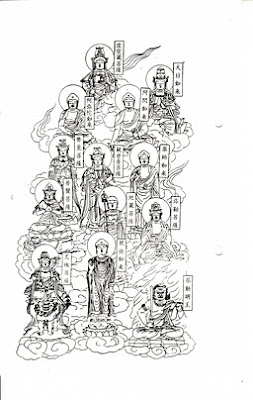
© www.taleofgenji.org
Pilgrimage in Kyoto
・ Fudo Myoo(Acalanatha Vidyaraja)
・ Shaka Nyorai (Shakyamuni Tathagata)
・ Monju Bosatsu (Manjusri Bodhisattva)
・ Fugen Bosatsu (Samantabhadra Bodhisattva)
・ Jizo Bosatsu (Ksitigarbha Bodhisattva)
・ Miroku Bosatsu (Maitreya Bodhisattva)
・ Yakushi Nyorai (Bhaisajyaguru Tathagata)
・ Kannon Bosatsu (Avalokitesvara Bodhisattva)
・ Seishi Bosatsu (Mahasthamaprapta Bodhisattva)
・ Amida Nyorai (Amithaba und Amitayus Tathagata)
・ Ashuku Nyorai (Aksobhya Tathagata)
・ Dainichi Nyorai (Mahavairocana Tathagata)
・ Kokuzo Bosatsu (Akasagarbha Bodhisattva)
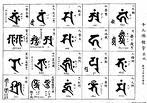

....................................................................................................................
Thirteen Butsu 十三仏 (Jūsanbutsu, Jusanbutsu).
Often mistakenly translated as “Thirteen Buddha,” for the group includes five Buddha 仏, seven Bodhisattva 菩薩, and one Myō-ō 明王. These 13 Buddhist deities are important to the Shingon school of Japanese Esoteric Buddhism. The 13 are invoked at the 13 memorial services held for the dead. They are associated with the 10 Kings of Hell and judgment in the afterlife. The grouping appeared around the 14th century and was popularized in the 15th. The grouping is considered a purely Japanese convention.
- source : Mark Schumacher -
:::::::::::::::::::::::::::::::::::::::::::::::::::::::::::::::::::::::::::::::::::::::::::::::::::::

- source : 仏像ワールド - facebook -
:::::::::::::::::::::::::::::::::::::::::::::::::::::::::::::::::::::::::::::::::::::::::::::::::::::
observance kigo for late spring
Annual Temple Visit for Children
(juusanmairi 十三参り)
juusan moode 十三詣で
chie moode 知恵詣(ちえもうで)
"praying for wisdom", chie morai 知恵貰い(ちえもらい)
On the 13th day of the third lunar month, now on April 13.
During the Edo period, there was a custom to bring a child to a special temple every year after birth until it was 13 (juusan). There was a different deity at each temple to introduce the child to and these 13 deities corresponded to the 13 benevolent deities that would later help the soul of the deceased to make its way through the various courts and judgements of hell, to have a good lawyer in the netherworld, so to speak.
To visit a different temple each year soon was too much for the busy people of Meiji times, so they cut it down to two visits, one after the birth and the last at age thirteen. There would soon be temples where the statues of all 13 deities were assembled to facilitate the visit. Since the main deity for the 13th visit was Kokuuzoo Bosatsu, his statue had to be the biggest. At Kakuon-ji temple in Kamakura, there is a cave with the statues of all these 13 deities well worth visiting.
Read more on this interesting cutsom in my Daruma Story:
. Anzan ― Daruma, Birth and Childrearing
. OBSERVANCES – SPRING SAIJIKI .
.................................................................................

Shrine Kurotatsu jinja 毛谷黒龍神社
〒918-8003 福井県福井市毛矢3丁目8-1
十三まいり御守り amulet for the Jusanmairi
chie mairi 知恵まいり shrine visit to gain wisdom
With a zodiac animal for each year.

:::::::::::::::::::::::::::::::::::::::::::::::::::::::::::::::::::::::::::::::::::::::::::::::::::::
13 Deities of the Shingon Sect
Fudô Myôô
Shaka Nyorai Monju Bosatsu Fugen Bosatsu Jizo Bosatsu Miroku Bosatsu Yakushi Nyorai Kannon Bosatsu Seishi Bosatsu Amida Nyorai Ashuku Nyorai Dainichi Nyorai Kokuzo Bosatsu
JUSAN BUTSU, the Thirteen Buddhas of the Shingon School, are often found represented together in painted images consisting of five Buddhas, seven Bodhisattvas and Fudô Myôô. All together they represent the chief deities of the Taizokai and Kongokai mandalas. In Shingon these thirteen Buddhas assist people during their life and continue to assist them after death to guide them into the realm of enlightenment.
The timeline, respectivley to the list above, of invocation by living Shingon followers for the deceased believer is as follows: seventh, fourteenth, twenty-first,twenty-eighth, thirty-fifth, forty-second, forty-ninth, one hundredth days and on the first year, third year, seventh-year, thirteenth year and thirty-third year memorials of a believer's death.
On each of the individual deities' pages you will see the image of the deity, to the right of which will be the deity's bija, or Sanskrit seed syllable, and the bija's Japanese and Sanskrit pronunciations.
© 1998 Shingon Buddhist International Institute
http://www.shingon.org/deities/jusanbutsu/jusanbutsu.html
The holy Mantram of each Deity
十三仏御真言 Juusanbutsu Go-Shingon
http://www.geisya.or.jp/~oterasan/okyou/jyuusan.htm
The special Properties of each Deity
十三仏の働き
http://www.geocities.jp/jyoryuzi3/jyusan2.htm
古園磨崖仏(十三仏)Koen Magaibutsu
There is a group of 13 statues, with Dainichi Nyorai in the middle (one of them is Fudo Myo-O:
. Stone Buddhas from Kunisaki 国東半島, Oita .
....................................................................................................................
Juusanbutsu on a Stone Stele, Yamauchi Town, Saga Prefecture
石造十三仏板碑 (町指定 石造建造物)
十三仏というのは鎌倉時代末期頃から近畿・北陸・中国地方において制作され、他の地域では限られた特定の範囲に流布されたといわれる、真言密教系の仏像であって死者の菩提を祈る際の本尊として選ばれた十三の仏である。 各尊はその忌日の本尊として、次のように定められている。
不動明王(初七日)釈迦如来(二七日)文殊菩薩(三七日)普賢菩薩(四七日)地蔵菩薩(五七日)弥勒菩薩(六七日)薬師如来(七七日)観世音菩薩(百ヶ日)勢至菩薩(一周忌)阿弥陀如来(三回忌)阿?如来(七回忌)大日如来(十三回忌)虚空蔵菩薩(三三回忌)
http://www.town.yamauchi.saga.jp/assets/assets_1.html
Stone Plate Monument of 13 Buddha Images in
Myokoji Temple (Myokoji Jusanbutsu Itabi)
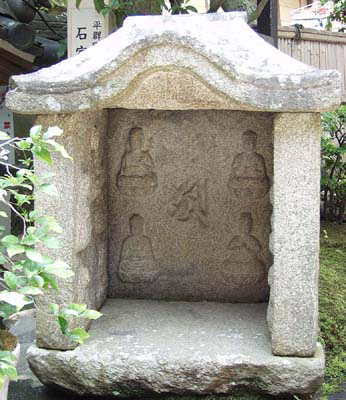
This is the granite plate monument 120cm tall, 28cm thick with a maximum width of 65cm.
The monument was created in the end of Muromachi Period and after, when two types of religion, belief in the land of Perfect Bliss (Gokuraku Jodo Shinko) and belief in guardian deity of children and ten governors to judge people's sin after death (Jizo Juo Shinko), were combined. The same types of plate are seen mainly around Mt. Ikoma chains in Kinki District.
The inscription that reads "the 3rd year of Koji Period (1557)" is a clue to read what the local community and the historic features of the city were like at that time. The same inscription is also seen on the stone monument "Thunder God "Stone (Raijinseki)" remaining in the same temple made by reusing the stone of the tombstone case.The Stone Plate Monument of 13 Buddha Images is introduced in the geographical description featuring Kawachi landmarks, "Kawachi Meisho Zue" edited in Edo Period.
.... www4.kcn.ne.jp/~sekibutu
13 Singular Statues for the Deities in Kawachi
十三の仏様が西を向いて並んでいます。左横にある石碑を見ると,昭和8年(1933年)地元の人によって建てられていることがわかります。
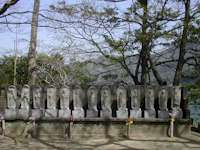
..... www.kita9.ed.jp/
........................................................................................................................
Hanging Scrolls with these Deities 十三仏図
Scroll for your home by Matsui San
十三仏(松井翔雲)
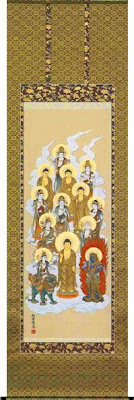
... www.rakuten.co.jp/kakejikuya/

source : facebook
十三仏図大津絵, Ōtsu-e of Thirteen Buddhist Deities
From the Shikoku Pilgrimage, with Kobo Daishi
http://www.eitikai.co.jp/s6-yamato13butu.htm
Painted on Silk, Sumitomo Foundation
絹本著色遣迎二尊十王十仏図(けんごうにそんじゅうおうじゅうぶつず)
真言宗の古刹、感神院木山寺に伝わる本図は、鎌倉時代に制作されたと考えられる。描かれている十王十仏は平安貴族の間で広まった極楽往生信仰が発展していくなかで描かれるようになり、十仏はやがて十一仏、十二仏と数が増えていき、室町時代には、十三仏となって確立されるが、この十王十仏は十三仏信仰の原初的形態をとどめる仏画として貴重である。
http://www.sumitomo.or.jp/jp0208.htm

Otsu-E type Painting 大津絵 十三仏
. . . CLICK here for Photos !
Read my Story
: Otsu-E, Pictures from Otsu大津絵
A whole set to paint your very own !
【ぬり絵写仏「十三仏セット」】
. . . CLICK here for Photos !
:::::::::::::::::::::::::::::::::::::::::::::::::::::::::::::::::::::::::::::::::::::::::::::::::::::

. tenugui 手ぬぐい Small Towels .
:::::::::::::::::::::::::::::::::::::::::::::::::::::::::::::::::::::::::::::::::::::::::::::::::::::
Pilgrimage to the 13 Temples of these Deities
................................ Chichibu
Temple Nr. 1 with Fudo Myo-O
http://www.nenjudo.co.jp/page/junreireport4.html
Japanese Link with Pilgrimages to 13 Deities and 6 Jizo
http://www5d.biglobe.ne.jp/~kanahori/higasikouyawalk.htm
:::::::::::::::::::::::::::::::::::::::::::::::::::::::::::::::::::::::::::::::::::::::::::::::::::::
. meido めいど the Netherworld .
- Introduction -
meido めいど【冥土 / 冥途】 the Netherworld, nether world
yomi 黄泉 "the yellow springs"
the world of the dead, the other world
The Japanese word "yomigaeru" よみがえる【蘇る / 甦る】has the meaning of "coming back from a visit to the Yellow Springs, yomi kara kaeru 黄泉(よみ)から帰る.
愚案ずるに冥土もかくや秋の暮
guanzuru ni meido mo kaku ya aki no kure
it seems to me that
beyond the grave is like this--
autumn evening
Tr. Addiss
in my humble view
the netherworld must be like this –
autumn evening
Tr. David Landis Barnhill
Written in 延宝8年作, Basho age 37
. Basho, Matsuo Basho 松尾芭蕉(1644 - 1694)
. Enma, Emma 閻魔天、閻魔王 the King of Hell
. yomi 黄泉 "the yellow springs" .
the Netherworld, nether world
:::::::::::::::::::::::::::::::::::::::::::::::::::::::::::::::::::::::::::::::::::::::::::::::::::::
Okinawa
kigo for the New Year
. toshibi iwai 年日祝 (としびいわい)
birthday celebration at the New Year .
From the second to the 13th (or 16th) of the first lunar month, families come together on the day of the corresponding zodiac animal to celebrate the birthday of
people of the age of 13, 25, 49, 61, 73, 85 and 97.
(13 is the next year after a full circle of 12 zodiac years.)
:::::::::::::::::::::::::::::::::::::::::::::::::::::::::::::::::::::::::::::::::::::::::::::::::::::::::::::::::::::::::::

Thirteen Buddhas:
Tracing the Roots of the Thirteen Buddha Rites
Steven J Hutchins
:::::::::::::::::::::::::::::::::::::::::::::::::::::::::::::::::::::::::::::::::::::::::::::::::::::
:::::::::::::::::::::::::::::::::::::::::::::::::::::::::::::::::::::::::::::::::::::::::::::::::::::
Die 13 Buddhas der Totenrituale (Juusanbutsu)
Siehe auch die 10 Höllenkönige.
Seit der Muromachi-Zeit weit verbreitete Glaubensform.
Nach dem Tode wurde die Seele im Verlauf von sieben mal sieben Tagen jeweils alle sieben Tage einer Gerichtssitzung in der Hölle unterworfen, danach wurde der Aufenthaltsort der Seele bestimmt. Später wurden allerdings noch drei Verhandlungen geführt, wie es in Sutra des Jizoo Bosatsu beschrieben steht. In der Edo-Zeit fügten die geschäftstüchtigen Tempel allerdings noch weitere drei hinzu, so daß heute 13 Höllenfürsten mit der Seele beschäftigt sind, zuletzt 33 Jahre nach dem Todestag. Bei jeder Höllen-Sitzung steht der Seele sozusagen ein Buddha als Verteidiger zur Seite, eben jeweils einer der 13 Buddhas.
Am 49. Tag (7 x 7) wird endgültig über den Verbleib der Seele beschieden, dabei spielt Yakushi Nyorai eine besondere Rolle. Am Vorabend dieses Tages werden 49 besonders große Reiskuchen (ein Shaku und seche Sun, entsprechend der Größe des Birushana) geopfert. Die meisten Seelen werden an diesem Tag für das Paradies freige~sprochen. Nicht ganz so gute Menschen kommen erst ab dem 3. Jahr nach dem Tode ins Paradies. Nur ganz wenige werden überhaupt nicht freigesprochen. Um diese Seelen für das Paradies zu retten, gehen die 13 Buddhas immer wieder in die Hölle, um mit den Höllenfürsten zu verhandeln. Spätestens 33 Jahre nach dem Tode kommt auch die Seele des schuldigsten Menschen dann ins Paradies.
Nach dem 33. Jahr hört die Existenz der Individual-Seele auf und sie wird nur noch insgesamt als Seele der Ahnen verehrt.
Früher wurde an jedem bedeutenden Todestag eine Bildrolle mit der entsprechenden Gottheit aufgehängt, heute ist dazu kaum noch Platz in den engen Wohnungen; daher gibt es jetzt eine Abbildung mit den 13 Buddhas, die man dem Toten unters Kopfkissen legt und dann auch zum Bon-Fest unter das Kopfkissen legen kann. Der Brauch, bei jedem Geburtstag eines Kindes den entsprechenden Buddha zu be~suchen und einen derartigen Tempel aufzusuchen (siehe juusan mairi), war in der Edo-Zeit noch weit verbreitet, schrumpfte aber inzwischen auf den Tempel~besuch am 13. Geburtstag zusammen. Es folgt eine Liste der Todestage, der entsprechenden Höllenfürsten und der ursprünglichen Buddha-Gestalten (honjibutsu).
Die 13 Höllenfürsten und die entsprechenden Buddhas
Erster 7. Tag Shinkoooo Fudoo Myoooo
Zweiter 7. Tag Shokoooo Shaka Nyorai
Dritter 7. Tag Sooteioo Monjuu Bosatsu
Vierter 7. Tag Gokanoo Fugen Bosatsu
Fünfter 7. Tag Enmaoo Jizoo Bosatsu
Sechster 7. Tag Henjoooo Miroku Bosatsu
Siebter 7. Tag Taizan Fukunoo Yakushi Nyorai
100ster Tag Byoodoooo Kannon Bosatsu
Erstes Jahr Zushioo Seishi Bosatsu
Drittes Jahr Godoo Tenrinoo Amida Nyorai
Siebtes Jahr Renjoooo Ashuku Nyorai
13. Jahr Hakkuoo Dainichi Nyorai
33. Jahr Jionoo Kokuuzoo Bosatsu.
.Buddhastatuen ... Who is Who
Ein Wegweiser zur Ikonografie
von japanischen Buddhastatuen
Gabi Greve, 1994
:::::::::::::::::::::::::::::::::::::::::::::::::::::::::::::::::::::::::::::::::::::::::::::::::::::
Ibaragi 茨城県 - 下八代町
byooninda 病人田 "the field of ill persons"
忌み地・忌み山
The place name 十三角田 is related to the concept of the Jusanbutsu at a funeral.
It was then changed to 忌田. It is a cursed field.
If someone tried to plough the field, he would get buried in the ground himself, or get ill of have some other kind of misfortune. So nobody used this field.
When during the hunger years after the War someone started ploughing the field, during a strom his home was hit by a mudslide and all were killed.
Fukushima 福島県 いわき市 Iwaki
At the temple 檀那寺 Dannadera if there is a funeral, a scroll with the Jusanbutsu is hung up and a box with the 六地蔵 Six Jizo is placed beside the dead.
Once a person refused to have the Six Jizo placed in the home. Soon after that the Six Jizo got wild and many people died in the village.
- source : Yokai database -
:::::::::::::::::::::::::::::::::::::::::::::::::::::::::::::::::::::::::::::::::::::::::::::::::::::
. YELLOW and haiku .
[ . BACK to WORLDKIGO TOP . ]
[ . BACK to DARUMA MUSEUM TOP . ]
:::::::::::::::::::::::::::::::::::::::::::::::::::::::::::::::::::::::::::::::::::::::::::::::::::::








4 comments:
Jusanbutsu with Fudo Myo-O
as a tenugui
Tenugui 手ぬぐい Small Towels
.
御府内八十八 福蔵院 -
Nr. 14
- 白鷺山 Shirasagizan 福蔵院 Fukuzo-In 正幡寺 Shoban-Ji
.
福蔵院の十三仏 Jusanbutsu - the 13 Buddha statues
They protect the souls of those passed-away on the journey in the Nether World
and also babies and children as they grow up until the age of 13 (juusan).
8 of the statues were made between 1666 and 1685. The other 5 had been destroyed and are made in 1769 on behalf of 27 pious people.
.
byooninda also called
忌田 imida ,エンギダ ,engida イワレの田 iware no ta
.
check yokai database
.
Ibaraki
病人田 Byoninda "the field of ill persons"
This is a field that will bring bad luck to the one who plow and use it.
Once upon a time, to prevent the flooding of Tonegawa, 河内屋 Kawachiya took it and wanted to build something. But he came to a hard layer of earth and could not continue. So for the rest of his life he was angry and died soon after. The field is now cursed.
https://edoflourishing.blogspot.jp/2018/01/tonegawa-river.html
Post a Comment